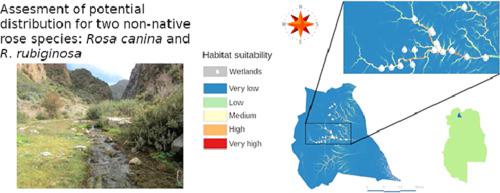当前位置:
X-MOL 学术
›
Ecol. Complex.
›
论文详情
Our official English website, www.x-mol.net, welcomes your
feedback! (Note: you will need to create a separate account there.)
Modeling habitat suitability and spread dynamics of two invasive rose species in protected areas of Mendoza, Argentina
Ecological Complexity ( IF 3.1 ) Pub Date : 2020-12-01 , DOI: 10.1016/j.ecocom.2020.100868 Ana C. Mazzolari , Emmanuel N. Millán , Eduardo M. Bringa , Diego P. Vázquez
Ecological Complexity ( IF 3.1 ) Pub Date : 2020-12-01 , DOI: 10.1016/j.ecocom.2020.100868 Ana C. Mazzolari , Emmanuel N. Millán , Eduardo M. Bringa , Diego P. Vázquez

|
Abstract Biological invasions are a main threat to biodiversity and natural resources, which calls for studies that identify the regions that present the greatest invasion risks. We assessed the potential distribution of two non-native rose species, Rosa canina and Rosa rubiginosa, in mountain environments in mid-western Argentina, using species distribution models and dynamic simulations. We first fitted the model for one protected area, Villavicencio Nature Reserve, and then we made predictions on the distribution of these species for other protected areas in the same region, where the presence of these species was observed but where there are no systematic surveys on their distribution. We also modeled the invasion dynamics of these species based on habitat suitability, considering the dispersal distance and the growth rate of the invaded area. High and very high suitability sites were detected in all the protected areas studied, suggesting high invasion risk in these protected areas. Our simulations of the spatio–temporal dynamics of the rose invasion in Villavicencio indicated that the spread depends strongly on the average seed dispersal distance, that the spread has been gradual since the rose introduction into the protected area, and that 150 years after the introduction even the areas identified as having low suitability are expected to have been invaded. This is the first study of this type for the region, where these invasive rose species are a serious problem. Taken together, our results may be useful to identify areas vulnerable to invasion and thus help generate effective preventive, monitoring, and control practices.
中文翻译:

阿根廷门多萨保护区两种入侵玫瑰物种的栖息地适宜性和传播动态建模
摘要 生物入侵是对生物多样性和自然资源的主要威胁,这需要研究以确定存在最大入侵风险的区域。我们使用物种分布模型和动态模拟评估了两种非本地玫瑰物种 Rosa canina 和 Rosa rubiginosa 在阿根廷中西部山区环境中的潜在分布。我们首先为一个保护区 Villavicencio Nature Reserve 拟合模型,然后我们对这些物种在同一地区其他保护区的分布进行了预测,在这些保护区观察到了这些物种的存在,但没有对这些物种进行系统调查。他们的分布。我们还根据栖息地适宜性对这些物种的入侵动态进行了建模,同时考虑了扩散距离和入侵区域的增长率。在所有研究的保护区中都检测到了高和非常高的适宜性地点,表明这些保护区的入侵风险很高。我们对比亚维森西奥玫瑰入侵的时空动态的模拟表明,传播强烈依赖于平均种子传播距离,自玫瑰引入保护区以来,传播一直是渐进的,甚至在引入后 150 年被确定为低适宜性的地区预计会遭到入侵。这是该地区首次进行此类研究,这些入侵玫瑰物种是该地区的一个严重问题。总之,我们的结果可能有助于识别易受入侵的区域,从而有助于产生有效的预防、监测和控制实践。
更新日期:2020-12-01
中文翻译:

阿根廷门多萨保护区两种入侵玫瑰物种的栖息地适宜性和传播动态建模
摘要 生物入侵是对生物多样性和自然资源的主要威胁,这需要研究以确定存在最大入侵风险的区域。我们使用物种分布模型和动态模拟评估了两种非本地玫瑰物种 Rosa canina 和 Rosa rubiginosa 在阿根廷中西部山区环境中的潜在分布。我们首先为一个保护区 Villavicencio Nature Reserve 拟合模型,然后我们对这些物种在同一地区其他保护区的分布进行了预测,在这些保护区观察到了这些物种的存在,但没有对这些物种进行系统调查。他们的分布。我们还根据栖息地适宜性对这些物种的入侵动态进行了建模,同时考虑了扩散距离和入侵区域的增长率。在所有研究的保护区中都检测到了高和非常高的适宜性地点,表明这些保护区的入侵风险很高。我们对比亚维森西奥玫瑰入侵的时空动态的模拟表明,传播强烈依赖于平均种子传播距离,自玫瑰引入保护区以来,传播一直是渐进的,甚至在引入后 150 年被确定为低适宜性的地区预计会遭到入侵。这是该地区首次进行此类研究,这些入侵玫瑰物种是该地区的一个严重问题。总之,我们的结果可能有助于识别易受入侵的区域,从而有助于产生有效的预防、监测和控制实践。











































 京公网安备 11010802027423号
京公网安备 11010802027423号